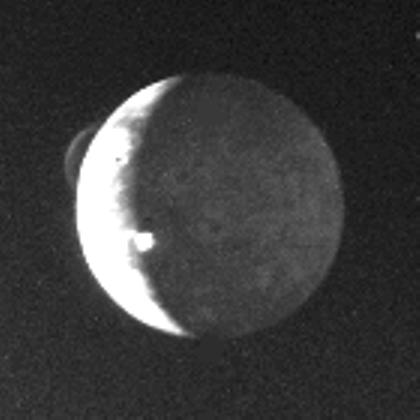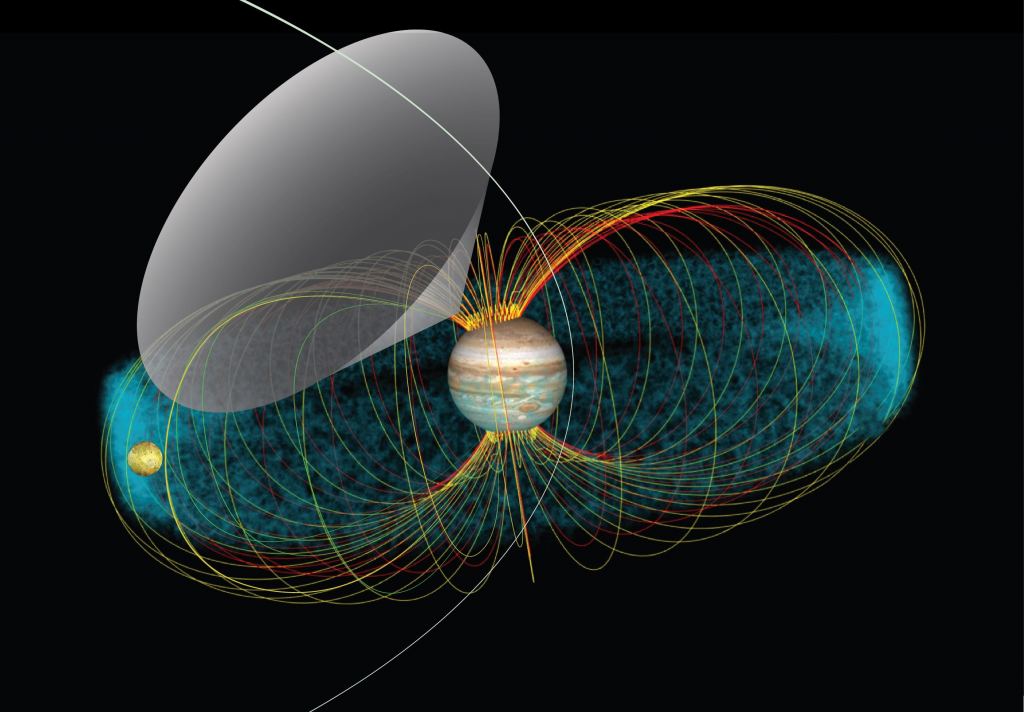For a tiny moon orbiting a giant planet, Io sure packs a giant wallop. It’s the most volcanic world in the solar system. Due to that extreme volcanism, scientists with the Juno mission are now focusing the spacecraft’s instruments and cameras on Io. They want to know more about its eruptions and how its constant stream of material into space interacts with Jupiter’s magnetosphere.
Over the next year and a half, the Juno spacecraft will make nine close flybys of Io. At least one loop will bring it within 1500 kilometers of the surface, giving an up-close and personal look at the volcanic action. “The team is really excited to have Juno’s extended mission include the study of Jupiter’s moons. With each close flyby, we have been able to obtain a wealth of new information,” said Juno Principal Investigator Scott Bolton of the Southwest Research Institute in San Antonio. “Juno sensors are designed to study Jupiter, but we’ve been thrilled at how well they can perform double duty by observing Jupiter’s moons.”
Io Bubbles with Volcanoes
Io is a rocky moon that orbits Jupiter at a close distance of only 422,000 kilometers. Galileo Galilei discovered this moon in 1610. In 1979, Voyager navigation team astronomer Linda Morabito noticed a plume in a Voyager 1 image. That discovery confirmed predictions of volcanic activity due to Io’s unique position in the Jovian system.

The volcanic activity on Io gives it a mottled, pizza-like appearance. There are hundreds of vents and calderas on the surface and these create a huge variety of interesting features. Volcanic plumes and lava flows across the surface show up in a palette of colors, from red and yellow to orange and black. Some of the lava “rivers” stretch for hundreds of kilometers.
Why is Io volcanic? Look at where it is. Jupiter on one side and two outer moons on the other. The planet’s huge gravity pulls on Io while Europa and Ganymede tug on it from their direction. That tug-of-war actually deforms Io, basically stretching and squeezing it. The friction of that action heats the interior, in a process called “tidal heating.” That causes the surface to bulge up and down as much as 100 meters. The result of the heating, heaving, and pulling, is a surface dotted with volcanic features.
Io constantly “repaves itself” with lava. That volcanism also feeds a thin atmosphere made mostly of sulfur dioxide. It also sends particles into the magnetosphere, where they create a huge donut-shaped “torus” of plasma surrounding Jupiter. The moon itself travels inside Jupiter’s much stronger and more extensive magnetosphere and the magnetic field lines trap particles from the torus. They spiral into the Jovian poles and create glowing auroral displays.
What Will Juno Learn Here?
The Juno spacecraft is on a two-year extended mission, focusing on the Jovian moons. It recently flew past Ganymede and Europa, gathering data about those two icy moons. It extended our view of Ganymede under the surface. At Io, it will speed through the extended torus of ions several times to get more information about the radiation environment. This is useful information for the upcoming JUICE and Europa Clipper missions.

The 9 flybys of Io will provide Junocam and other instruments ample opportunity to get high-resolution images of the rugged Io surface and provide plenty of other data about this tiny moon. It has already made one infrared image showing the glowing hotspots of its eternally active volcanoes.
As it loops the moons, Juno also will continue to study Jupiter, focusing on its internal structure, magnetic field, atmosphere, and magnetosphere. As its orbit slowly evolves over the next two years, it will focus on studies of the Io and Europa torus regions. In addition, Juno will continue its study of the dusty faint rings of Jupiter. All the images and data should give a much fuller understanding of the activities on Jupiter, its moons, and how they are interconnected.
For More Information
NASA’s Juno Exploring Jovian Moons During Extended Mission
Juno Mission
Discovery of Volcanic Activity on Io: A Historical Review (links to PDF)
The post Juno’s has Been Touring Jupiter’s Moons on its Extended Mission. Next Stop: Volcanic Io appeared first on Universe Today.
No comments:
Post a Comment